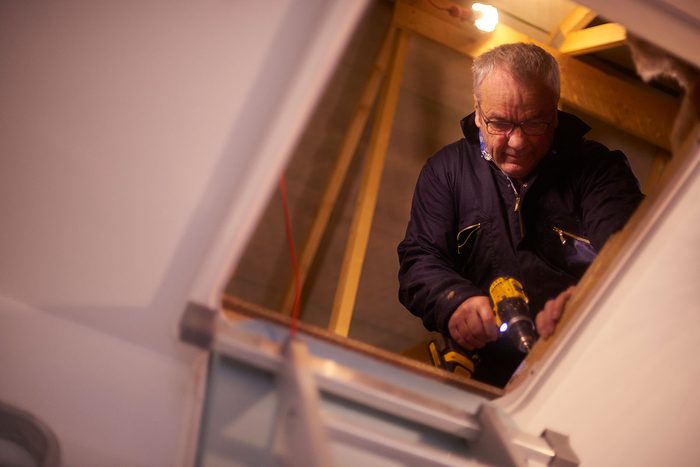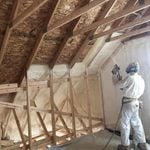What to Know About Finishing Your Attic’s Flooring

Got an unfinished attic you'd like to convert to living space? Flooring matters. Learn which attic flooring approach makes sense for you.
Few home projects are more rewarding to a DIYer than turning an unfinished basement or attic into comfortable, finished living space.
Some attics provide a great spot for an additional living room, guest bedroom or activity area. One of the main considerations when finishing your attic is flooring. Choosing the right attic flooring — that is, if your attic can be finished at all — depends on structural elements and layout. Learn about attic flooring options, and which attic finishing approach makes sense for you.
On This Page
How To Know if You Can Add Attic Flooring
Before installing flooring in your attic, it’s vital to examine the space with a critical eye. Some attics can safely handle flooring right away without major modifications to the space or structure. Others require a major overhaul before flooring can go down. And some attics simply aren’t meant to be finished.
Here are some things to look for when determining if your attic is suitable for flooring:
- Floor joists: These are the horizontal framing members of what will become your finished attic floor. Joists create the base over which you’ll install the floor. Depending on the age and intended use of the space, these might be 2×6 (1-1/2-in. x 5-1/2-in.), 2×8 (1-1/2-in. x 7-1/2-in.), 2×10 (1-1/2-in. by 9-1/2-in.) or 2×12 (1-1/2-in. by 11-1/2-in.). The wider and more closely spaced your joists, the stronger your attic floor, and the better suited it will be to supporting furniture and heavy objects. If your joists are only 2×6 or 2x8s, you probably shouldn’t proceed until a professional builder has reinforced the floor frame.
- Framing: Many modern roofs are framed with factory-assembled “webs” of wood called trusses. These are the exact shape and angle of your roof, and make the job of framing it a whole lot faster and easier for builders. Trouble is, trusses drastically reduce the amount of usable attic space due to their floor-to-ceiling webbing. If your attic is built with trusses, there’s probably not much point in trying to use it for anything more than a storage space. Roofs framed with rafters or structural insulated panels (SIPs) are different. Both create attics that are wide open and ready for finishing.
- Insulation: Before installing any flooring in your attic, make sure the attic insulation is adequate. Many attics in older homes were built strictly for storage and have no roof insulation. Instead, they rely on insulation between the attic floor joists to keep the rooms below warm in winter and cool in summer. If this is your situation, you’ll need to install batts, spray foam or blown in cellulose insulation between the rafters forming your roof frame before worrying about flooring. If your home is built of SIPs there’s no issue, because SIPs contain built-in foam insulation.
How To Determine How Much Weight Attic Flooring Can Support
Knowing the weight capacity of the attic’s floor structure is essential for anyone thinking of converting an attic to living space. Floor loading capacity is a product of room size and joist span, width and spacing. In North America, it’s usually expressed in pounds per square foot (PSF).
Building code requirements vary from place to place, but most jurisdictions insist on common room floors handling at least 40 PSF, and sleeping rooms handling 30. Use this calculator to learn the maximum span of your attic joists, plugging in the load requirements as outlined in your local building code. Use this information along with the size of your attic space to determine if your floor frame is up to code for a finished room.
What Kind of Attic Flooring Works Best in Different Situations?
If your attic is completely unfinished, it might not even have plywood subfloor installed on top of the floor joists. If not, installing this subfloor is your first job. Go with sheets of plywood at least 5/8-in. thick and preferably 3/4-in. for maximum strength. Then it’s time to choose your finished flooring material, which will be fastened on top of the subfloor. There are three options.
Tongue-and-groove wood
Most building supply stores carry 3/4-in. tongue-and-groove softwood lumber of various lengths and widths. This is a simple, fairly economical flooring approach, and can look nice after sanding and finishing.
Tongue-and-groove refers to routed profiles along the boards’ edges, allowing them to interlock quickly and easily with their neighbors. The only real downside is that seasonal temperature changes can cause the boards to expand and contract, creating small gaps between them over time. This option also means lots of work and time invested in establishing and maintaining a durable finish.
Engineered hardwood
One solution to the expansion and contraction problem is engineered hardwood. Made of thin strips of real pre-finished hardwood factory bonded to tongue-and-groove plywood (which doesn’t expand and contract significantly), engineered flooring is a great way to enjoy the beauty of hardwood with little trouble.
Laminate
The trouble with real wood flooring is that no matter how many coats of finish you apply, it’ll eventually wear out and start looking ugly. If you don’t have the time, patience or skill to refinish your attic flooring regularly, consider a laminate floor. Composed of tough plastic made to look like wood, most laminates will far outlast real wood. They’re extremely scratch and wear resistant, easy to install and resemble real wood.
Other flooring options
Rigid sheet flooring is another option that works well, is easy to install and resists wear. Tiles are almost never a good choice for attics because attic floors are rarely strong and rigid enough to prevent small amounts of flexing, which causes tiles and grout to crack. The quickest of all attic flooring options is simply carpeting right over the bare subfloor.


